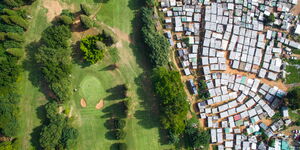On Monday, September 14, UN-Habitat Kenya published the Nairobi City County Public Space Inventory and Assessment Report, detailing how Nairobi's public spaces have been 'disappearing' since the pre-colonial period.
"Nairobi County has currently over 826 public spaces. The 3,000 hectares include 99 playgrounds, 51 sports fields, 15 parks and 19 gardens. Combined, Ngong and Karura forests span 1,930 hectares and represent over 60 per cent of Nairobi’s public spaces," reads an excerpt from the report.
However, the situation on the ground is quite different. On the very day the report was published, Amnesty International's Kenya chairperson Renée Ngamau was arrested for rallying her neighbourhood - Jamhuri phase 1 estate association to block a public land grab.
Speaking to Kenyans.co.ke, Renee narrated how her move to block a private developer landed her in trouble with the police.
"The developer came to meet the residents and said he has never needed permission wherever he has dug boreholes and there is nothing anyone can do. We reported at least four incidents of harassment and threats at Kilimani and Jamhuri Police Stations, but nothing was done.
Yesterday, the developer started digging a trench across a public playground. The residents came out in numbers and I called the chief who said he'd look into it. Last night 11 officers from Jamhuri Police Post came to arrest me and I was charged with malicious damage. We go to court this morning. No file. No complainant. The bond was extended to Wednesday, September 23, 2020," she detailed.
Her's has been the story of countless other social activists who have stood up to private developers looking to convert public property into private profit-driven developments.
On January 19, 2015, renowned photojournalist Boniface Mwangi and hundreds of children from Lang'ata Road Primary School grabbed international headlines as they were tear-gassed by the police while defending their school's playground.
Speaking to Kenyans.co.ke, Mwangi was happy to point out that it was worth every tear, as the playground is still part of the school to date.
"There were two other schools as well namely Racecourse Primary School and Naka Primary School, which we managed to reclaim from the hands of the so-called private developers," he detailed.
According to the UN-Habitat report, Nairobi's initial master plan drawn up in 1948 envisioned Nairobi to be a green city, affectionately referred to as the ‘green city in the sun’, with broad boulevards, roundabouts and large areas of parkland and forest reserves.
Public spaces featured prominently in the Master plan. They represented 29.25% of the total land within the planning boundary.
The master plan emphasized that as far as practicable, there should be an ‘open space’ at the centre of each neighbourhood unit, to be used partly as a recreational space and partly as a reserve of sites for public or semi-public buildings like nursery or junior schools, clinics, libraries, and clubs.
While documenting the history of Nairobi’s Urban Planning, and with special reference to the years preceding 1927, it was observed that Nairobi’s urban development was based on market-driven subdivision of land which was propelled principally by the desire to maximize profits.
This is pretty much a trend that has remained to date. It records, “One by one, estates were subdivided and slowly covered with buildings. Engineering services were inadequate and expensive because of the untidy and sprawling development. Most serious of all, there was overcrowding as estate owners tried to increase the value of the undeveloped land."
The post-independence era was characterised with illegal misappropriation of public spaces, inadequate management, inadequate budgetary allocations and rapid expansion of informal settlements. It brought with it a lot of shrinking of Nairobi’s public space system.
Flash-forward to the millennial era, which is when the death of the urban commons in Nairobi was declared.
From the 1980s right up to the year 2000, city governance neglected public space and the commons were largely assumed by crime and violence which had a negative impact on investment choices, livable spaces and livelihood opportunities.
Conversion of existing public spaces to other development purposes often assumed to be more economically viable, became the norm.
"Nairobi City County Government and the Nairobi Metropolitan Service do not have an up-to-date database of public open spaces within their respective jurisdictions," the report reads in part.
The Covid-19 pandemic has drastically impacted public life and how we live in cities, the impacts continue to be felt in different sectors and especially in congested residential areas.
Public space has emerged as a critical lifeline for cities and their residents, making the need to protect what is left of Nairobi's public spaces even more critical.












